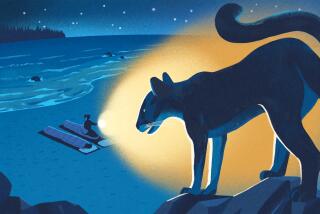Excavation Yields Hints of Ferocious Prehistoric Fight
- Share via
How is this for a battle: a saber-toothed cat versus a lion the size of a Siberian tiger. The fight may have actually taken place 30,000 years ago near Wilshire Boulevard and Curson Avenue in the Wilshire district.
Paleontologists have been making discoveries at the La Brea Tar Pits recently that lend credence to the thought that the ferocious fight may have occurred.
Fossils of an extinct lion, much larger than the African lion, are among the highlights of the ongoing excavation at the La Brea Tar Pits. The excavation, open to public viewing, continues until Sept. 1.
The excavation, led by paleontologists and assisted by volunteers, is part of the annual two-month dig of Pit 91, which is located just north of the rear door of the Los Angeles County Museum of Art. The digs began in 1969 and funding only permits two months of work a year.
“This year’s work has yielded significant discoveries,” said Christopher A. Shaw, collections manager of the George C. Page Museum of La Brea Discoveries.
In the last two weeks, more then 200 specimens have been uncovered at Pit 91, which is considered one of the world’s richest fossils deposits.
Found in the pits was the lower jaw of the extinct lion, known as felis atrox. Shaw said the extinct lion was up to a third larger than present-day African lions and could have weighed 750 pounds. He said there was evidence to suggest this lion did not travel in prides as today’s lions do, and may have roamed the area alone 25,000 to 33,000 years ago.
The skull of a saber-toothed cat was also uncovered. Unlike the lion, the saber-toothed cat was a social animal. Discoveries have found that wounded cats were cared for by other saber-toothed cats.
Another discovery that Shaw described as “very exciting” was intestines of a giant ground sloth, which will give major clues to its eating habits.
As for any fight between the saber-toothed cat and the lion, Shaw said that although the cat was about half the weight of the lion, it was very powerful, and if it had other cats along to fight the lone lion, it might have an advantage.
Visitors to the George C. Page Museum can watch the excavation from the visitors’ observation deck. There is no extra charge to watch the paleontologists and volunteers dig. Those interested in volunteering for next year’s dig must be at least 16 and complete 96 hours of lab work before they can join in the actual excavation.
More to Read
Sign up for Essential California
The most important California stories and recommendations in your inbox every morning.
You may occasionally receive promotional content from the Los Angeles Times.













